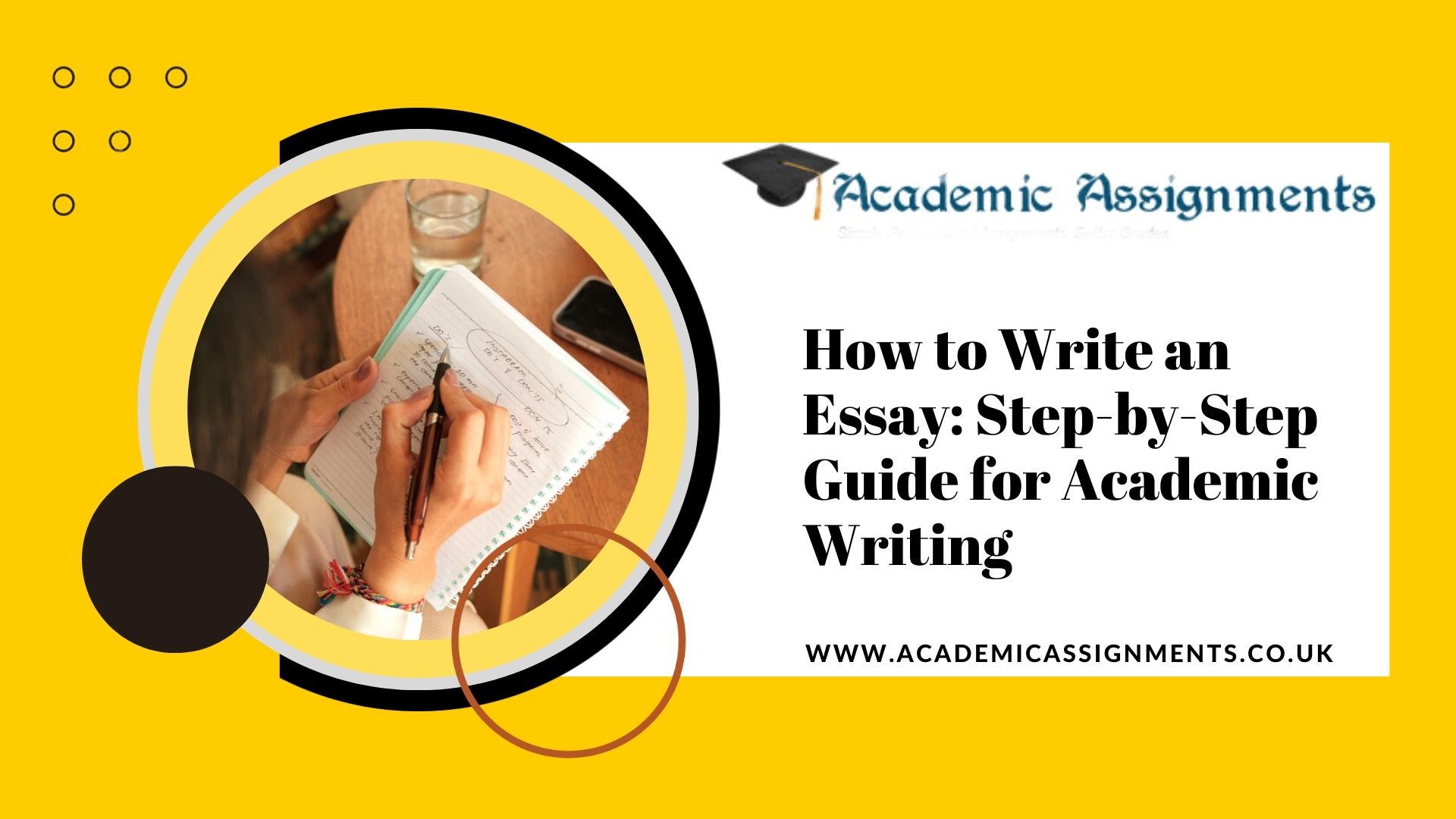How to Write an Essay: Step-by-Step Guide for Academic Writing
An essay is an interpretative, analytical and critical composition which is less systematic, formal and much shorter than a thesis or a dissertation. It usually deals with its main subject from a personal and limited perspective. Before writing an essay, a writer must consider three things – thesis, audience and type. The thesis is the most important of all, as it explains the essay. The necessary points of the essay are summed up in the thesis statement, which is called the central point the writer is trying to describe in his essay. Sometimes, essays are strayed and moved in the related areas, but they come back to explain the thesis idea. Before starting writing, the writer must pinpoint the thesis. If the writer is stuck somewhere while writing, think, “What is the most significant thing that I would like my audience to keep in mind after they’ve finished reading the essay?” It’s preferable to mention the thesis as early as possible, perhaps in the topic phrase if feasible. It should be repeated throughout the essay, particularly if the writer is summing up every detail. The remaining portion of the essay should then back up the argument: scientific proof, testimonies, logical conclusions, or even compelling speech to get the point through. The key is that the writer expands on the initial premise rather than going to another issue.
Essays are of 6 types
- An argumentative essay is a thesis which makes use of facts and shreds of evidence to support the affirmation that it is making. Its goal is to coax the audience to concur with the affirmed argument.
- The admissions essay is a piece of writing written by a prospective student. It is a component of the admission process that tries to convey a sense of the applicant`s direct personality to the admission panel. This demonstrates writing abilities and the ability to articulate ideas and thoughts logically.
- A persuasive essay is a form of essay that uses logical reasoning combined with arousing feelings to persuade readers to accept a specific perspective. It’s comparable to an argumentative essay in that they firmly support a certain perspective, but the final purpose differs.
- Compare and contrast essay is an informative or analytical essay examining the similarities and contrasts between two subjects to gain a broader understanding. The writer has the option of focusing just on comparing, solely on contrasting, or both.
- A personal essay is a brief written piece in which the author describes a personal occurrence or noteworthy event based on their own experiences or beliefs. It is a brief work of creative nonfiction composed in the first person. It allows one to express oneself by writing about a life event, personal accomplishment, or perspective. They are also a literary type of language many nonfiction authors use when reflecting on an experience, concept or event.
- An expository essay requires students to examine a concept, evaluate evidence, expand on the subject, and present a clear and concise argument on the idea. The final contemplation is the audience reading the essay. No matter what is being written in the essay, the audience should be influenced by the language of the essay. They must determine whether the written essay is casual or formal. It has a huge impact on the essay’s word choice, writing style and language. The essay’s tone is also affected by the audience or how the writer sounds emotionally (confidently, enthusiastically or cautiously).
There are 5 steps to writing an essay. These are described as follows.
- Brainstorming is usually beneficial for coming up with ideas before beginning to write. It assists in producing as many ideas for the essay that are feasible based on the topic or argument. It is the initial step for writing any assignment or essay. It is also known as prewriting. When brainstorming, the notion of “free writing” might be useful. Writing down any thought that comes to mind during free writing. Putting those thoughts down in words, no matter how disconnected they appear initially, is a vital component of brainstorming.
- Preparation is a crucial stage in the writing process, involving outlining the essay and gathering supportive resources. Evaluate the outcomes of brainstorming, identify essential concepts for the argument, and arrange them logically. This step also includes determining the essay format, such as APA, Chicago, or MLA, and searching for empirical evidence or appropriate citations based on the chosen style guide. These style guides provide specific guidelines for referencing various sources like news articles, web pages, statements, and YouTube videos.
- Drafting is the key phase of the essay`s creation, in which the writer pulls up his sleeves and begins composing the initial draft. While writing the initial draft, some things could be improved. And one cannot expect to go flawless while writing the first draft and can miss the broader picture if focusing on writing every word correctly.
- Revising is undertaking a literary endeavour that normally necessitates several rounds of revision. When rewriting, one of the most crucial aspects to remember is to consider your reader’s perspective. Peer editing is highly encouraged. This process involves the third, fifth or even tenth draft if required. Address any small details or intricacies that are missed in the initial draft. Consider choosing words and understanding, as well as complex writing methods such as eliminating using a passive voice and revising the writing skills by ensuring that the writing material is clear, concise and readable by checking the structure of the sentence and word choices.
- Proofreading is the last step of the writing process. After all the heavy-duty modifications have been completed, it is the moment to apply the final polish. Correct any misspellings, formatting difficulties, or grammatical flaws in your essay. Make certain that all of the references are included and structured correctly. Read your document aloud to help you slow down to spot minor grammar and spelling issues that tools for editing may miss. You should read your writing several times to ensure it is thorough and indicative of your finest work.
Essay Structure
When developing the essay’s framework, there are two things to remember: ensuring to include the correct material in each section and selecting how to organise the content inside the body. An essay’s fundamental form always includes an introduction, a body, and a conclusion.
- Introduction – Essay openers adopt the same standards as any other type of writing, focusing on expressing the subject matter, preferably in the main phrase. The audience should understand what your essay focuses on at the end of your opening paragraph. It must include a catchy hook for the audience or make the essay seem engaging, and it can start with a quotation concerning the specific topic. It ensures that the introduction transitions from broad to particular regarding the topic. It gives the audience an organised “road plan” for the essay. The final part of the introduction should feature a crucial element called the thesis statement, which holds utmost importance. The thesis statement articulates the purpose of the essay and may incorporate examples and evidence provided by the author.
- Body – The greater part of the essay comprises body paragraphs supporting the thesis and providing proof. Paying great attention to how the body paragraphs are organised. Certain arguments profit from logical progression, in which one point leads to another, and the next point leads to the next. Additionally, this section includes the paper
s support and evidence from the writers viewpoint. Each paragraph should commence with a topic sentence that establishes a connection to the thesis statement. These paragraphs should be structured logically, employing three different types: chronological order for narratives involving time, spatial order for descriptive purposes from top to bottom, and emphatic order for emphasizing importance in college writing. Furthermore, the inclusion of transition sentences fosters a smooth flow within the essay. Relevant examples and facts are incorporated to bolster the argument, and proper citation is crucial to ensure the relevance of each instance to the specific topic at hand. - Conclusion – This part should include a summary of your contentions and ideas. It should simplify the key ideas and ensure the audience has plenty to ponder, especially if it is a critical essay.
The length of the essay can be simple enough. It can be done five paragraphs essay style, which includes an introduction of 1 paragraph, the main body of the essay of 3 paragraphs and the conclusion of 1 paragraph.
Writing Tips for an Essay
- Development of Thesis – A thesis statement is the heart of the essay – the statement being made, the argument that is attempting to establish. It comprises one or two phrases from the introduction that convey the stance on the issue.
- Strong Form – An outstanding essay organises its ideas logically. The structure of the content should be simple to understand. The introduction should lead into the body paragraphs organically, and the conclusion should bring the entire thing together. The easiest method to accomplish this is to create an outline for the essay before starting. Examine the form once finishing the article to determine if the thoughts flow freely.
- Style – The writing style of the essay reflects the writer`s writing identity. And fluency can be seen by writing accurate phrases with varying forms. A professional writer employs a variety of sentence structures and idiomatic phrases and shows an understanding of genre-specific language.
- Conventions – Punctuation, grammar, spelling and structuring of sentences are all examples of conventions. A high number of errors shows carelessness and undermines the validity of your claims.
- Support and References – Choosing credible sources for the essay. Using quotations and paraphrases to back up the points, make sure to attribute the sources properly and use the proper format for citations such as Harvard, Chicago, APA and MLA.
- Seek out another pair of eyes – It is usually a good idea to have another person read the work before finalising it. We sometimes need to pay more attention to the trees for the woods, and spending too much time thinking about the same thing can lead to a narrow focus. The remedy is to gain a new perspective from somebody experiencing it for the initial period.
Author Bio: Mark Edmonds is a renowned academic writer and an esteemed assignment help provider at Academic Assignments. With years of experience and expertise in essay writing, Mark has assisted countless students in achieving academic success. Known for delivering top-quality essays, he ensures meticulous attention to detail and a step-by-step approach in his writing process. Students trust Mark for his ability to offer reliable and affordable essay writing service without compromising quality. With his guidance, students can confidently navigate the complex world of academic writing and excel in their assignments.

 Blogs
Blogs





